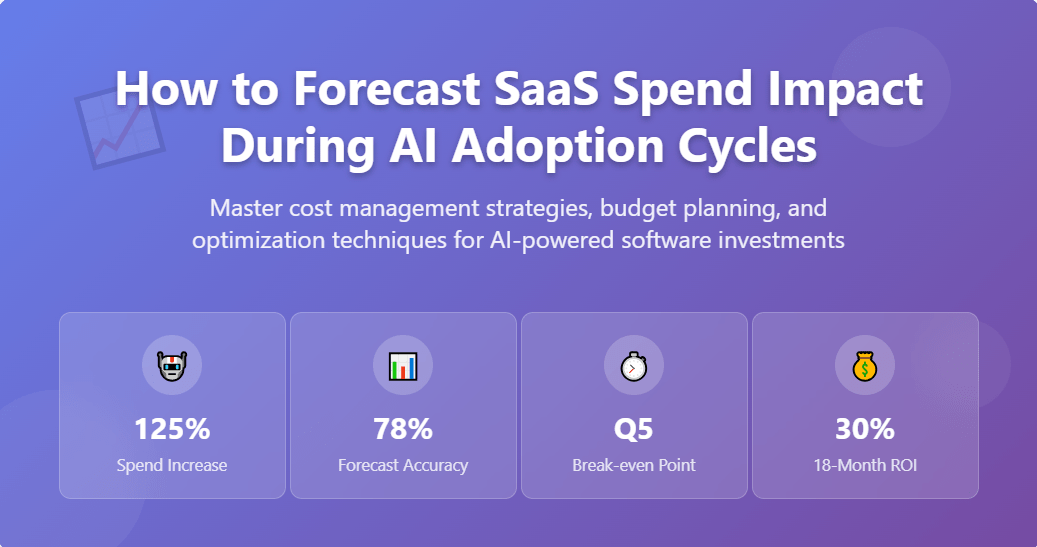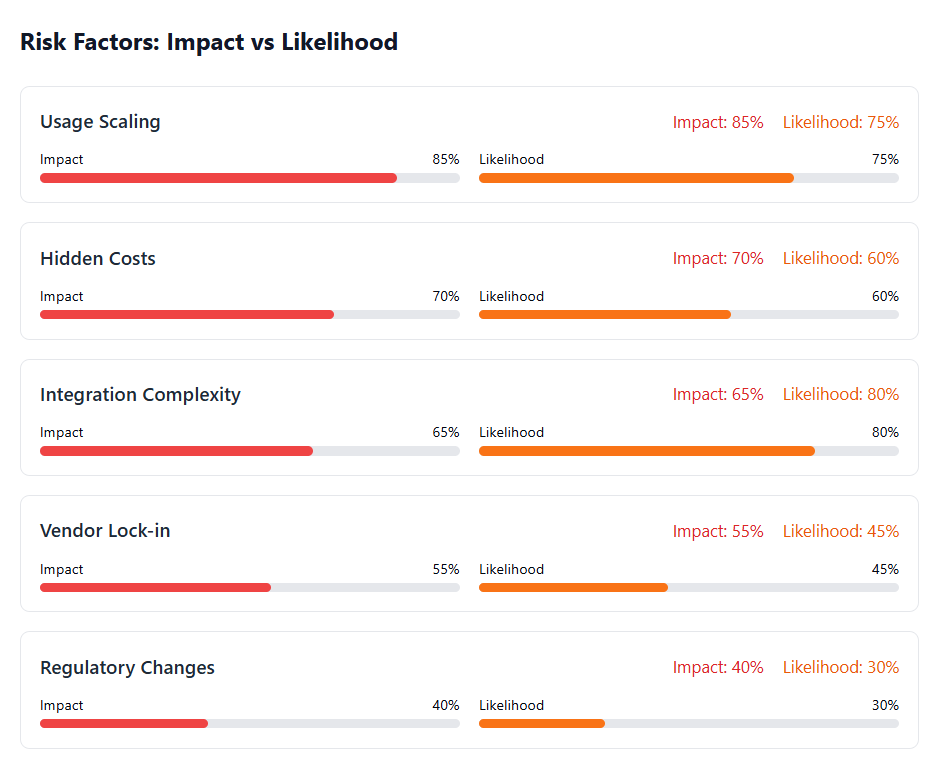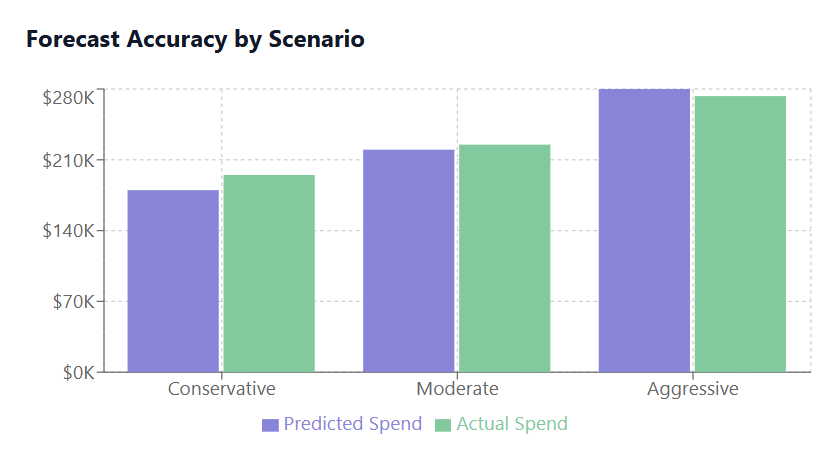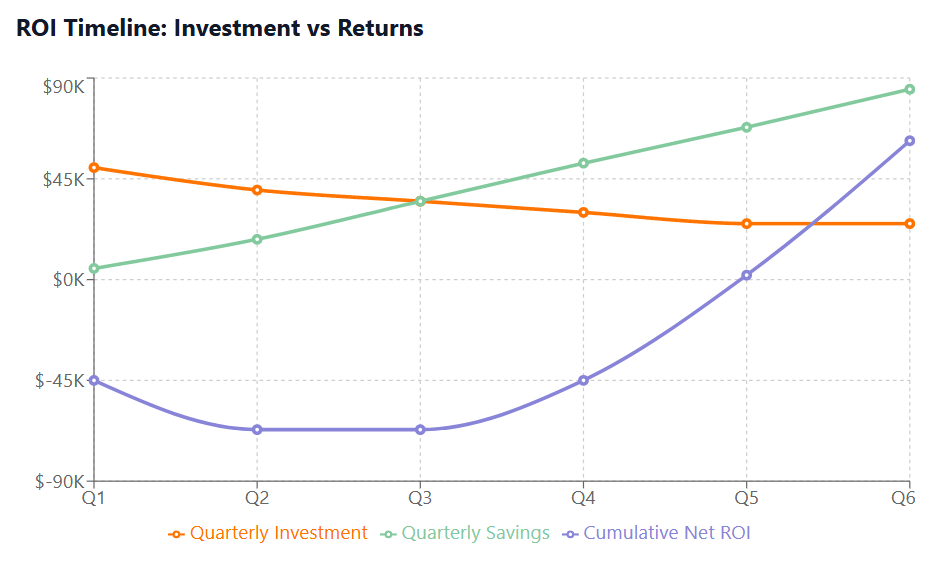
The integration of artificial intelligence into business operations has fundamentally transformed how organizations approach software procurement and SaaS spend management. As companies embark on AI adoption cycles, the complexity of forecasting SaaS expenditures increases exponentially, requiring sophisticated approaches to budget planning and cost optimization.
Understanding how to effectively forecast SaaS spend impact during AI adoption cycles has become crucial for financial planning and operational success. Organizations that master this capability can optimize their software investments, avoid budget overruns, and maximize the return on their AI initiatives while maintaining cost-effective SaaS operations.
This comprehensive guide provides actionable strategies, proven methodologies, and real-world insights to help businesses navigate the intricate landscape of SaaS cost forecasting during AI transformation. By implementing the frameworks and best practices outlined here, organizations can make informed decisions about their AI-powered SaaS investments and ensure sustainable growth in the digital age.
What is AI-Driven SaaS Adoption?
AI-driven SaaS adoption refers to the strategic integration of artificial intelligence capabilities within Software as a Service applications and platforms. Unlike traditional SaaS implementations, AI-powered solutions incorporate machine learning algorithms, natural language processing, predictive analytics, and automated decision-making capabilities to enhance functionality and user experience.
This evolution represents a significant shift from conventional SaaS software distribution models, where applications primarily served as digital tools. AI-enabled SaaS platforms now function as intelligent assistants, capable of learning from user behavior, automating complex processes, and providing predictive insights that drive business value.
The adoption cycle typically involves several phases: initial assessment and tool selection, pilot implementation, gradual rollout across departments, full-scale deployment, and continuous optimization. Each phase presents unique cost implications and spending patterns that require careful forecasting and budget management.
Modern AI-driven SaaS solutions encompass various categories, including customer relationship management systems with predictive analytics, human resources platforms with automated candidate screening, financial software with fraud detection capabilities, and marketing tools with personalized campaign optimization. These applications often require additional data storage, processing power, and specialized integrations that significantly impact overall spending patterns.
The Impact of AI on SaaS Spending Patterns
The integration of artificial intelligence into SaaS platforms creates distinct spending patterns that differ substantially from traditional software investments. Understanding these patterns is essential for accurate cost forecasting and effective cloud cost optimization.
Increased Initial Investment Requirements
AI-powered SaaS solutions typically demand higher upfront investments compared to conventional software. These costs stem from premium pricing for AI features, extensive data preparation and migration requirements, specialized training for team members, and often more robust infrastructure to support machine learning workloads.
Variable Usage-Based Pricing Models
Many AI-enabled SaaS platforms employ consumption-based pricing structures, where costs fluctuate based on the volume of data processed, number of AI operations performed, or computational resources utilized. This shift from predictable subscription models to variable pricing creates forecasting challenges and requires sophisticated budget planning approaches.
Compounding Growth in Data Processing Costs
As AI systems learn and improve, they often require increasing amounts of data processing and storage. This growth pattern can lead to exponential cost increases over time, particularly for organizations that experience rapid business growth or expand their AI use cases across multiple departments.
Integration and Ecosystem Expansion Expenses
AI adoption frequently drives the need for additional complementary tools and integrations. Organizations may need to invest in data warehousing solutions, API management platforms, security tools specifically designed for AI workloads, and specialized analytics dashboards to maximize the value of their AI investments.

Key Challenges in Forecasting AI-Related SaaS Costs
Accurate forecasting of SaaS expenses during AI adoption cycles presents unique challenges that traditional budgeting approaches cannot adequately address. Understanding these challenges is crucial for developing effective forecasting strategies and avoiding common pitfalls.
Unpredictable Usage Scaling Patterns
AI systems exhibit non-linear usage growth patterns that are difficult to predict using historical data. As machine learning models become more sophisticated and users discover new applications, computational requirements and associated costs can increase dramatically and unexpectedly.
Complex Pricing Structures and Hidden Costs
AI-powered SaaS vendors often employ intricate pricing models that include multiple variables such as data processing volume, model complexity, API calls, storage requirements, and premium feature access. These multifaceted structures make it challenging to accurately predict monthly or annual expenses, especially as usage evolves.
Interdependencies Between AI Tools and Existing Systems
The integration of AI capabilities often requires modifications to existing SaaS infrastructure, leading to cascading cost implications. Organizations may need to upgrade current subscriptions, purchase additional licenses, or invest in integration platforms to ensure seamless connectivity between AI tools and legacy systems.
Rapid Technology Evolution and Feature Expansion
The fast-paced development of AI technology means that vendors frequently introduce new features, capabilities, and pricing tiers. These changes can significantly impact cost structures and require constant monitoring and forecast adjustments to maintain accuracy.

Essential Components of AI Adoption Cost Forecasting
Developing a comprehensive forecasting framework for AI-related SaaS expenses requires careful consideration of multiple cost components and their interdependencies. A systematic approach ensures that all potential expenses are identified and accurately estimated.
Core AI Software Licensing and Subscription Costs
The foundation of any AI cost forecast includes the direct licensing fees for AI-powered SaaS platforms. These costs typically encompass base subscription fees, user licenses, premium AI feature access, and any enterprise-level capabilities required for organization-wide deployment.
Data Processing and Computational Resource Expenses
AI applications consume significant computational resources for training models, processing data, and generating insights. Forecasting must account for cloud computing costs, data storage fees, bandwidth charges for data transfer, and processing power requirements that scale with usage intensity.
Integration and Implementation Services
Successful AI adoption often requires professional services for implementation, customization, and integration with existing systems. These costs include consulting fees, system integration services, custom development work, and project management expenses that occur during the adoption phase.
Training and Change Management Investments
Organizations must invest in employee training, change management initiatives, and ongoing support to ensure successful AI adoption. These human capital investments are essential for maximizing the value of AI tools and should be factored into comprehensive cost forecasts.
Ongoing Maintenance and Optimization Expenses
AI systems require continuous monitoring, optimization, and maintenance to deliver optimal performance. Forecasts should include costs for system administration, model retraining, performance optimization, and technical support beyond the initial implementation period.
Strategies for Accurate SaaS Spend Forecasting During AI Integration
Implementing effective forecasting strategies requires a combination of analytical rigor, stakeholder collaboration, and adaptive planning approaches. Organizations that master these strategies can achieve more accurate predictions and better control over their AI-related SaaS investments.
Develop Multi-Scenario Forecasting Models
Create multiple forecast scenarios based on different adoption speeds, usage patterns, and business growth trajectories. Conservative, moderate, and aggressive scenarios help organizations prepare for various outcomes and make informed decisions about budget allocation and risk management.
Implement Granular Usage Tracking and Analytics
Establish comprehensive monitoring systems to track actual usage patterns, cost trends, and performance metrics across all AI-powered SaaS applications. This data provides the foundation for refining forecasts and identifying optimization opportunities throughout the adoption cycle.
Establish Cross-Functional Forecasting Teams
Form collaborative teams that include IT professionals, finance experts, business stakeholders, and data scientists to ensure comprehensive cost analysis. Each perspective contributes valuable insights that improve forecast accuracy and stakeholder buy-in for budget decisions.
Leverage Historical Data and Industry Benchmarks
While AI adoption patterns are relatively new, organizations can analyze available historical data from similar implementations, industry benchmarks, and vendor-provided usage statistics to inform their forecasting models and validate assumptions.
Build Flexibility and Contingency Planning
Design forecasting frameworks that can accommodate rapid changes in usage patterns, pricing structures, and business requirements. Include contingency budgets and regular review cycles to ensure forecasts remain relevant and accurate throughout the adoption process.

AI-Powered SaaS Tools and Their Cost Implications
Different categories of AI-enabled SaaS tools present unique cost structures and forecasting challenges. Understanding these variations helps organizations develop more accurate predictions and optimize their software portfolios.
Customer Relationship Management and Sales AI
AI-powered CRM platforms like Salesforce Einstein, HubSpot AI, and Microsoft Dynamics 365 AI incorporate predictive analytics, lead scoring, and automated customer insights. These tools typically charge based on user licenses plus additional fees for AI features, with costs scaling based on data volume and complexity of AI operations.
Human Resources and Talent Management AI
HR platforms with AI capabilities for recruiting, performance management, and employee analytics often employ tiered pricing models. Costs vary based on employee count, recruitment volume, and the sophistication of AI features utilized, with many vendors charging premium rates for advanced predictive analytics.
Marketing Automation and Analytics AI
AI-driven marketing platforms combine traditional automation features with machine learning-powered personalization, campaign optimization, and customer journey analytics. Pricing structures typically reflect contact database size, email volume, and AI processing requirements for real-time personalization.
Financial Management and Analytics AI
Financial SaaS tools with AI capabilities for fraud detection, risk assessment, and predictive financial planning often charge based on transaction volume, data processing requirements, and the complexity of AI models deployed. These costs can fluctuate significantly based on business growth and transaction patterns.
Business Intelligence and Data Analytics AI
AI-enhanced BI platforms like Tableau with AI, Power BI AI features, and specialized analytics tools charge based on user licenses, data processing volume, and computational resources required for machine learning operations. Costs often increase exponentially with data volume and model complexity.
Building an AI-Ready SaaS Budget Framework
Creating a robust budget framework for AI-driven SaaS adoption requires strategic planning, stakeholder alignment, and flexible resource allocation. A well-designed framework enables organizations to optimize their investments while maintaining financial discipline.
Establish Clear Budget Categories and Allocation Guidelines
Structure budgets into distinct categories such as core AI software licenses, integration and implementation services, training and change management, ongoing maintenance and support, and contingency reserves for unexpected costs or opportunities.
Implement Dynamic Budget Adjustment Mechanisms
Design budget frameworks that allow for regular adjustments based on actual usage patterns, changing business requirements, and evolving AI capabilities. Quarterly reviews and reallocation processes ensure budgets remain aligned with organizational priorities and market conditions.
Create ROI Measurement and Validation Processes
Develop comprehensive metrics and KPIs to measure the return on investment from AI-powered SaaS tools. These measurements help justify budget allocations, identify optimization opportunities, and inform future investment decisions through data-driven analysis.
Establish Vendor Management and Negotiation Strategies
Implement systematic approaches to vendor evaluation, contract negotiation, and relationship management. Focus on obtaining flexible pricing terms, clear cost escalation policies, and performance guarantees that protect against unexpected expense increases.
Integrate with Enterprise FinOps and Cost Management Practices
Align AI-related SaaS budgeting with broader financial operations and cloud cost management initiatives. This integration ensures consistent cost governance, reporting standards, and optimization practices across all technology investments.

Monitoring and Adjusting Forecasts Throughout AI Implementation
Effective forecast management requires continuous monitoring, analysis, and adjustment throughout the AI adoption lifecycle. Organizations that implement robust monitoring practices can identify issues early and optimize their spending proactively.
Establish Real-Time Cost Monitoring Dashboards
Deploy comprehensive monitoring systems that provide real-time visibility into SaaS spending, usage patterns, and cost trends across all AI-powered applications. These dashboards enable rapid identification of anomalies, optimization opportunities, and budget variance issues.
Implement Automated Alert and Escalation Systems
Configure automated alerts for unusual spending patterns, budget threshold breaches, and significant cost variances. These systems ensure prompt attention to potential issues and enable proactive cost management before problems become critical.
Conduct Regular Forecast Accuracy Reviews
Schedule periodic reviews to compare actual costs against forecasted amounts, analyze variance causes, and refine forecasting methodologies. These reviews help improve future predictions and identify systematic forecasting biases or gaps.
Perform Continuous Vendor and Contract Optimization
Regularly assess vendor performance, contract terms, and pricing structures to identify optimization opportunities. This includes renegotiating contracts based on usage patterns, consolidating vendors where appropriate, and evaluating alternative solutions for better value.
Maintain Cross-Departmental Communication and Alignment
Establish regular communications between IT, finance, and business stakeholders to ensure forecasts reflect changing business requirements, upcoming initiatives, and strategic priorities. This alignment prevents forecast drift and improves organizational buy-in.
Case Studies: Good and Poor AI-Related SaaS Spending Practices
Learning from real-world examples of successful and unsuccessful AI-related SaaS spending helps organizations avoid common pitfalls and implement best practices for cost management and forecasting.
Successful AI SaaS Spending Practices
Case Study 1: Gradual Rollout with Comprehensive Monitoring
A mid-sized financial services company implemented a phased approach to AI-powered customer service tools. They began with a pilot program in one department, established comprehensive usage monitoring, negotiated flexible pricing terms with vendors, and gradually expanded based on proven ROI. This approach enabled accurate forecasting and cost control throughout the adoption process.
Case Study 2: Cross-Functional Planning and Vendor Consolidation
A manufacturing organization formed a cross-functional team including IT, finance, operations, and data science professionals to plan their AI adoption. They consolidated multiple AI tools under a single vendor ecosystem, negotiated enterprise pricing, and implemented shared cost allocation models. This strategy reduced overall costs and simplified forecast management.
Case Study 3: Data-Driven Budget Optimization
A retail company used historical usage data and predictive analytics to forecast their AI-powered inventory management costs. They implemented automated scaling policies, established clear cost thresholds, and regularly optimized their tool configurations based on actual performance metrics. This approach achieved 30% cost savings compared to initial projections.
Poor AI SaaS Spending Practices
Case Study 1: Uncontrolled Tool Proliferation
A technology startup allowed individual departments to independently adopt AI tools without central oversight. This resulted in redundant capabilities, incompatible systems, excessive licensing costs, and no coherent forecasting strategy. The company eventually spent 200% more than necessary and achieved minimal integration benefits.
Case Study 2: Inadequate Usage Monitoring and Cost Control
A healthcare organization implemented multiple AI-powered diagnostic tools without establishing proper monitoring systems. Usage-based pricing led to unexpected cost escalations, budget overruns of 150%, and emergency budget reallocation that disrupted other technology initiatives.
Case Study 3: Over-Investment in Unproven Technologies
A consulting firm invested heavily in cutting-edge AI tools without proper evaluation or pilot testing. Many tools provided minimal business value, required extensive customization, and generated ongoing maintenance costs that weren’t factored into initial forecasts. The organization ultimately discontinued 60% of their AI investments.
Leveraging Automation for SaaS Spend Management During AI Adoption
Implementing automated approaches to SaaS spend management becomes increasingly important as AI adoption introduces complexity and scale that manual processes cannot effectively handle. Automation enables more accurate forecasting, proactive cost optimization, and efficient resource allocation.
Automated Usage Tracking and Cost Allocation
Deploy automated systems that continuously monitor AI-powered SaaS usage across all departments and projects. These systems can track user activity, computational resources consumed, data processing volumes, and feature utilization to provide granular cost insights and enable accurate chargeback or showback models.
Intelligent Cost Anomaly Detection
Implement machine learning-powered anomaly detection systems that can identify unusual spending patterns, unexpected cost increases, or inefficient resource utilization. These systems learn normal usage patterns and automatically alert administrators to potential issues before they impact budgets significantly.
Automated Vendor Management and Contract Optimization
Utilize automated tools to track vendor performance, contract terms, renewal dates, and pricing changes across all AI-powered SaaS subscriptions. These systems can identify optimization opportunities, trigger contract renegotiation processes, and ensure organizations receive optimal value from their investments.
Dynamic Resource Scaling and Cost Optimization
Implement automated scaling policies that adjust AI-powered SaaS resources based on actual demand and usage patterns. These policies can automatically scale up during peak periods and scale down during low-usage times, optimizing costs while maintaining performance requirements.
Integrated Forecasting and Budget Management
Deploy AI-powered forecasting tools that analyze historical usage patterns, business growth trends, and market conditions to generate more accurate predictions for AI-related SaaS spending. These tools can automatically adjust forecasts based on changing conditions and provide scenario analysis for different adoption strategies.
Tools like Binadox provide comprehensive SaaS spend management capabilities that are particularly valuable during AI adoption cycles. These platforms offer automated discovery of AI-powered applications, usage analytics, cost optimization recommendations, and integrated forecasting capabilities that simplify the management of complex AI-related SaaS portfolios.
Future Trends in AI-Driven SaaS Cost Management
The landscape of AI-powered SaaS cost management continues to evolve rapidly, with emerging trends that will significantly impact how organizations approach forecasting and budget management for AI initiatives.
Predictive Cost Management and AI-Powered Forecasting
Advanced AI systems are being developed specifically for SaaS cost management, capable of analyzing complex usage patterns, predicting future spending with high accuracy, and automatically recommending optimization strategies. These systems will revolutionize how organizations forecast and manage their AI-related SaaS investments.
Integration of FinOps Principles with AI Cost Management
The convergence of FinOps methodologies with AI-specific cost management practices is creating new frameworks for optimizing AI spending. These integrated approaches emphasize collaborative cost management, real-time optimization, and continuous improvement processes tailored to AI workloads.
Emergence of AI-Specific Pricing Models and Marketplaces
SaaS vendors are developing new pricing models specifically designed for AI workloads, including outcome-based pricing, performance-linked fees, and risk-sharing arrangements. These models will require new forecasting approaches and cost management strategies.
Advanced Automation and Autonomous Cost Optimization
Future SaaS management platforms will incorporate autonomous optimization capabilities that can automatically adjust resource allocation, negotiate contract terms, and optimize spending without human intervention. These systems will enable more efficient cost management and reduce the administrative burden of AI adoption.
Enhanced Integration with Cloud Cost Management Platforms
The boundary between SaaS and cloud infrastructure costs continues to blur as AI-powered applications require significant computational resources. Future cost management platforms will provide unified visibility and optimization across both SaaS subscriptions and underlying cloud infrastructure costs.
Regulatory and Compliance Impact on AI Cost Management
Emerging regulations around AI usage, data privacy, and algorithmic transparency will introduce new compliance costs and requirements that must be factored into forecasting models. Organizations will need to account for these evolving regulatory expenses in their AI-related SaaS budgets.
Conclusion
Successfully forecasting SaaS spend impact during AI adoption cycles requires a comprehensive approach that combines analytical rigor, stakeholder collaboration, and adaptive planning methodologies. Organizations that master these capabilities can optimize their AI investments, avoid budget overruns, and achieve sustainable growth in the digital economy.
The key to effective forecasting lies in understanding the unique characteristics of AI-powered SaaS applications, implementing robust monitoring and analysis systems, and maintaining flexibility to adapt to changing conditions and requirements. By following the strategies and best practices outlined in this guide, organizations can navigate the complexities of AI adoption while maintaining financial discipline and maximizing return on investment.
As the AI landscape continues to evolve, forecasting approaches must also adapt to accommodate new technologies, pricing models, and business requirements. Organizations that invest in developing sophisticated forecasting capabilities and automated cost management systems will be better positioned to capitalize on AI opportunities while managing financial risks effectively.
The future of AI-driven SaaS cost management will be characterized by increased automation, more sophisticated predictive capabilities, and deeper integration with enterprise financial operations. By preparing for these trends and implementing the foundational practices described in this guide, organizations can ensure they are ready to optimize their AI-related SaaS investments and achieve their digital transformation objectives.
Through careful planning, continuous monitoring, and strategic optimization, businesses can harness the power of AI-enabled SaaS solutions while maintaining cost-effective operations and predictable budget management. The investment in developing these capabilities will pay dividends as AI adoption accelerates and becomes increasingly central to competitive advantage in the digital economy.

